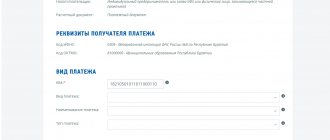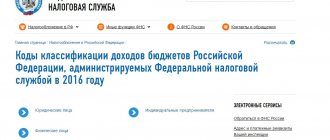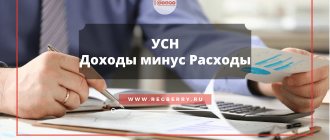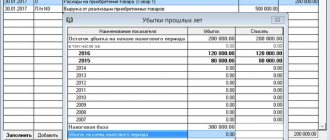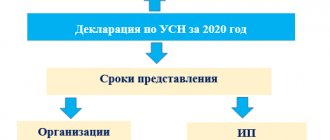Companies and individual entrepreneurs operating under the special simplified tax system “Income minus expenses”, i.e. Those who pay a single tax on the difference between income receipts and expenses incurred are required to follow the requirements of tax legislation, which establishes a list of costs taken into account when calculating the tax. In other words, not all expenses can be recognized as “simplified” expenses, even if they are impeccably documented. Let us recall the rules for recognizing income and expenses under the simplified tax system “Income minus expenses” in force in 2021, which must be followed when calculating tax.
General information about the simplified tax system
Chapter 26.3 of the Tax Code of the Russian Federation is devoted to the procedure for applying the simplified tax system. To obtain the right to use it, the following conditions must be met:
- annual revenue - no more than 150 million rubles;
- residual value of fixed assets - no more than 150 million rubles;
- number of employees - no more than 100 people;
- the share of participation in other organizations should not exceed 25%;
- lack of branches.
The system assumes the possibility of choosing two tax bases:
The taxpayer has the right to choose one of them. The choice determines the recognition of income under the simplified tax system, the procedure for recognizing costs, as well as the applicable tax rates.
The moment of recognizing expenses under the simplified tax system and setting up 1C
A screenshot of the settings of one of the versions of 1C: Accounting 8.3, given below, will help you deal with a typical “error” of KUDiR.
From this screenshot you can see what conditions are necessary to recognize expenses that reduce the single tax base. The settings are shown for the simplified tax system with the “income - expenses” base, which, however, should be clear, since with a simplified tax system of 6% (the “income” base), expenses do not affect the amount of tax paid at all. If you do not have any expenses included in the KUDiR, then check whether all the conditions for the established procedure for recognizing expenses of this type in the simplified taxation system are met.
It is worth noting that before keeping records, you needed to properly configure your 1C, since it is just a program and it itself does not know what exactly you want from it. If you see the settings window above (or similar to it in another version of 1C 8) for the first time, it means you did not bother to configure 1C before entering your documents into the database!
Simplified taxation system “income – expenses”
When forming the taxable base “income – expenses”, a rate of 15% is applied. It can be lowered by regional authorities in the range from 5 to 15%. Or establish a differentiated rate for different categories of taxpayers. For example, in St. Petersburg, for all taxpayers using the simplified tax system “income-expenses”, the tax rate is 7%.
Tax payable is calculated as follows:
A special feature of this type of simplified taxation system is the need to pay a minimum tax. It is 1% of the proceeds received. It must be paid even if the company suffered a loss as a result of its activities.
Tax base for the simplified tax system Income minus Expenses
Of course, when you first get acquainted with the simplified tax system Income minus Expenses, you may get the impression that a more profitable taxation system in the Russian Federation simply does not exist (subject to the minimum possible rate of 5%). However, it is necessary to analyze the possibility of using this version of the simplified tax system in your particular case not only arithmetically.
If everything is quite clear with the tax rate of this regime, then with the other element of taxation, i.e. tax base, a lot of questions arise. Unlike the simplified tax system for Income, where the tax base consists only of income received, the tax base for the simplified tax system for Income minus Expenses is income reduced by the amount of expenses, and to calculate it, it is necessary to correctly confirm the expenses incurred.
Prepare a simplified taxation system declaration online
At its core, the calculation of the single tax on the simplified tax system Income minus expenses is much closer to the calculation of income tax than to the version of the simplified tax system Income. It is no coincidence that Chapter 26.2 of the Tax Code of the Russian Federation, dedicated to the application of the simplified system, several times refers to the provisions governing the calculation of income tax.
The main risk for the taxpayer here is that the tax inspectorate does not recognize the expenses declared in his return under the simplified tax system. If the tax authorities do not agree with the formation of the tax base, then in addition to arrears, i.e. additional tax assessment, a penalty will be calculated and a fine will be imposed under Art. 122 Tax Code (20% of the unpaid tax amount).
✐ Example ▼
In the declaration under the simplified tax system, Dolphin LLC declared income received in the amount of 2,876,634 rubles. and expenses incurred in the amount of RUB 2,246,504. The tax base, according to the taxpayer, amounted to 630,130 rubles, and the amount of tax at a rate of 15% is 94,520 rubles.
Accounting for expenses incurred was carried out according to KUDiR data, and copies of documents confirming the fact of business transactions and payment of expenses were attached to the declaration, at the request of the tax authority. The expenses include (in rubles):
- purchase of raw materials and supplies – 743,000
- purchase of goods intended for resale – 953,000
- salary and insurance premiums for compulsory insurance – 231,504
- office rent – 96,000
- rental of industrial premises – 127,000
- third party accounting services – 53,000
- communication services – 17,000
- office refrigerator – 26,000.
Based on the results of a desk audit of the declaration, the tax inspectorate accepted the following expenses to reduce the tax base:
- purchase of raw materials and materials - 600,000, because materials worth RUB 143,000. were not accepted from the supplier
- purchase of goods intended for resale – 753,000, because not all purchased goods were sold to the buyer
- salary and insurance premiums for compulsory insurance – 231,504
- office rent – 96,000
- rental of industrial premises – 127,000
- communication services – 17,000.
The cost of purchasing a refrigerator for the office in the amount of 26,000 rubles. were not accepted as not related to the business activities of the organization. Also, the costs of third-party accounting services in the amount of 53,000 rubles were considered economically unjustified, because there was a sufficiently qualified accountant on staff whose responsibilities included full accounting services for the organization. In total, expenses were recognized in the amount of 1,824,504 rubles, the tax base was 1,052,130 rubles, and the amount of tax payable was 157,819 rubles.
Tax arrears were accrued in the amount of RUB 63,299. and a fine under Art. Tax Code of the Russian Federation (incomplete payment of tax amounts as a result of understatement of the tax base), in the amount of 20% of the unpaid tax amount, i.e. RUB 12,660
Note: to this amount it is also necessary to add penalties for late payment of under-accrued amounts of advance payments, which will require indicating income and expenses quarterly.
Simplified tax system calculator
Revenue recognition rules
The moment of recognition of income under the simplified tax system “income” does not differ from the procedure for their recognition under the simplified tax system “income - expenses”. The procedure for recognizing income under the simplified tax system is prescribed in paragraph 1 of Art. 346.17 Tax Code of the Russian Federation. For the simplified taxation system, the cash method is used.
The date of recognition of income under the simplified tax system “income - expenses” is the day the money is received in a bank account or at the cash desk. If repayment of debt or other material benefit is received in the form of other property, work, services or property rights, then it must be taken into account at the time of their receipt.
For example, when repaying a buyer's debt for goods by offset, the receipt of funds must be taken into account on the date of offset of counterclaims.
Cash method - right or obligation
The cash method is convenient because the main accounting principle is cash flow, that is, the situation typical of the accrual method does not arise when the work is completed, the money has not yet been received, but there is already a sale, that is, it is necessary to pay tax.
This principle is clear and convenient for small organizations or individual entrepreneurs, as well as if the organization operates by providing deferred payments to clients. And the question arises - who has the right to apply the specified accounting system, and in what cases this application is mandatory. After all, the cash method means that receiving an advance is also income and you must pay tax, even if the work has not yet been completed and the advance may have to be returned.
First of all, it must be said that the cash method can be used under different taxation systems:
- general taxation system (OSNO),
- simplified taxation system (STS).
There is no alternative to the simplified tax system; only the cash method is used. But with regard to the general system, the situation is different - this is the right to choose, which is not granted to all taxpayers. If the accrual method can be used by any organization on OSNO, then the cash method must be fixed in the accounting policy and can be used under a number of restrictions and conditions.
Expense recognition rules
Costs under the simplified taxation system are recognized in accordance with the closed list established by clause 1 of Art. 346.16 Tax Code of the Russian Federation.
For most expenses, the moment of recognition of expenses under the simplified tax system is recognized as the date of actual payment. But there are exceptions to this rule.
simplified tax system 15%: recognition of expenses
| Type of expenses | What's included | Date of recognition | The basis on which expenses are recognized under the simplified tax system |
| Material | Purchase of production materials, raw materials, components. |
For postpayment - on the date of payment.
For prepayment - when the prepaid goods arrive.
As purchased goods are sold. One of the assessment methods must be used:
- at average cost;
- at the cost of each unit;
- FIFO (at the cost of the first in time of acquisition).
For postpayment - on the date of payment.
In case of prepayment - when the prepaid services will be provided.
If advertising costs are normalized (cost of prizes, organization of incentive lotteries, placement of information in third party catalogs, etc. (clause 4 of Article 264 of the Tax Code of the Russian Federation)), then they are taken into account within 1% of paid revenue.
Paragraph 2 p. 2 art. 346.16.
Clause 4 art. 264 Tax Code of the Russian Federation.
Costs of acquisition, production, construction of fixed assets and intangible assets.
Similarly, the costs of modernization, retrofitting or reconstruction of the operating system are taken into account.
Cash method under OSNO
Conditions of application and restrictions are established in paragraph 1 of Art. 273 of the Tax Code of the Russian Federation, in particular, cannot apply the cash method for OSNO:
- banks;
- microfinance organizations;
- credit consumer cooperatives;
- participants in a property trust management agreement;
- participants in a simple partnership agreement.
In addition to restrictions on types of activities, the general restriction established by paragraph 1 of Art. 273 of the Tax Code of the Russian Federation for all organizations - revenue excluding VAT on average for the previous four quarters should not exceed 1 million rubles. for every quarter.
This means that every quarter it is necessary to analyze the revenue received for previous periods and calculate the average. At the same time, the calendar year is not a reference period; any consecutive quarters are taken into account, that is, to confirm the right to use the cash method in the third quarter, data from the 1st, 2nd quarters of the current and 3rd, 4th quarters of the previous year must be taken for calculation. And if the total revenue exceeds the established amount, then the taxpayer will need to apply the accrual method starting from January 1 (clause 4 of Article 273 of the Tax Code of the Russian Federation).
Expenses in the case of using the cash method under OSNO are determined with the features established by clause 3 of Art. 273 Tax Code of the Russian Federation.
What expenses cannot be recognized?
Despite the fact that the list of accepted costs, named in Art. 346.16, includes all the main costs that arise when conducting business; some payments cannot be taken into account:
- entertainment expenses that the taxpayer has the right to take into account on the OSN cannot be taken into account by the simplifier;
- the amount of advances transferred to suppliers for goods, works and services that will be received in the future. These payments can be taken into account only after the receipt of goods, works and services;
- VAT, which the simplified taxation system payer allocated in invoices issued to customers and paid to the budget;
- the simplified tax itself.
The Ministry of Finance in its clarifications emphasizes that the list of accepted costs under the simplified tax system is closed. It will not be possible to take into account other costs (Letter dated March 23, 2017 No. 03-11-11/16982).
Information about changes:
Federal Law of July 21, 2005 N 101-FZ Article 346.17 of this Code is stated in a new wording, which comes into force on January 1, 2006.
Article 346.17. Procedure for recognizing income and expenses
GUARANTEE:
Information about changes:
Clause 1 amended from September 29, 2021 – Federal Law of September 29, 2021 N 325-FZ
1. For the purposes of this chapter, the date of receipt of income is the day of receipt of funds into bank accounts and (or) the cash desk, receipt of other property (work, services) and (or) property rights, as well as repayment of debt (payment) to the taxpayer in another way (cash method).
When the buyer uses a bill of exchange in payments for goods (work, services) purchased by him, the date of receipt of income from the taxpayer is the date of payment of the bill of exchange (the day of receipt of funds from the drawer or another person obligated under the specified bill of exchange) or the day the taxpayer transfers the specified bill of exchange by endorsement to a third party.
How to calculate tax with a simplified tax system of 15%?
The difference between income and expenses is the taxable base under the simplified tax system. It is determined by the cumulative total from January 1 to December 31 of the current year, then the calculation starts from scratch.
The single tax under a simplified system with the object “income minus expenses” is equal to the base multiplied by the rate of 15%.
The amount of the simplified tax system (USN) of 15% is calculated at the end of the year. Before the end of the year, advance payments must be made based on the results of the first quarter, half a year and nine months. The amount of the advance payment is found in the same way as the amount of the tax itself. When transferring, previous advance payments accrued for this year are taken into account.
Also, at the end of the year, you need to calculate the so-called minimum tax. It is equal to the income received during the year multiplied by 1%. Then you need to compare two figures: the simplified tax system is 15% and the minimum. The larger amount should be paid to the budget. When transferring money, advance payments for the current year are taken into account.
An example of calculating the simplified tax system “income minus expenses”
Silva LLC is engaged in consulting in the Moscow region. In this region, for this type of activity, the simplified tax rate with the object “income minus expenses” is set at 15%.
First quarter
In the first quarter of 2021, the income of Silva LLC amounted to 400,000 rubles, and expenses - 310,000 rubles.
The advance payment under the simplified tax system of 15% for the first quarter is equal to 13,500 rubles. ((RUB 400,000 – RUB 310,000) × 15%).
Half year
In the second quarter of 2021, the income of Silva LLC amounted to 500,000 rubles, and expenses - 430,000 rubles.
The advance payment for six months is 24,000 rubles. ((RUB 400,000 + RUB 500,000) – (RUB 310,000 + RUB 430,000) × 15%).
Silva LLC transferred 10,500 rubles to the budget. (RUB 24,000 – RUB 13,500).
Nine month
In the third quarter of 2021, the income of Silva LLC amounted to 480,000 rubles, and expenses - 390,000 rubles.
The advance payment for nine months is equal to 37,500 rubles ((400,000 rubles + 500,000 rubles + 480,000 rubles) – (310,000 rubles + 430,000 rubles + 390,000 rubles) × 15%).
Silva LLC transferred 13,500 rubles to the budget (37,500 rubles – 10,500 rubles – 13,500 rubles).
Year
In the fourth quarter of 2021, the income of Silva LLC amounted to 150,000 rubles, and expenses - 100,000 rubles.
The single tax for 2021 is equal to 45,000 rubles ((400,000 rubles + 500,000 rubles + 480,000 rubles + 150,000 rubles) – (310,000 rubles + 430,000 rubles + 390,000 rubles + 100 000 rub.) × 15%).
The amount of the minimum tax is 15,300 rubles ((400,000 rubles + 500,000 rubles + 480,000 rubles + 150,000 rubles) × 1%).
The accountant found that the simplified tax system of 15% (RUB 45,000) is more than the minimum tax (RUB 15,300). Taking into account advance payments, Silva LLC transferred the amount of 7,500 rubles to the budget. (45,000 rub. – 13,500 rub. – 10,500 rub. – 13,500 rub.).
Revenue under the simplified tax system for 2019–2020
One of the main requirements regarding the possibility of using the simplified tax system by a company or individual entrepreneur is the established limit on the level of annual income, which should not exceed 150 million rubles. (clause 4 of article 346.13 of the Tax Code of the Russian Federation).
The procedure for accounting for income under the simplified tax system is determined by Art. 346.15, 346.17 Tax Code of the Russian Federation. Regarding their composition, paragraph 1 of Art. 346.15 refers to sec. 1 and 2 tbsp. 248 Tax Code of the Russian Federation. According to the text of these paragraphs, the amount of income under the simplified tax system is formed by the sum of income:
- from implementation;
- non-operating;
- from gratuitously received property or rights to it.
Income does not include receipts listed in Art. 251 Tax Code of the Russian Federation.
Revenue consists of sales (subclause 1, clause 1, article 248 of the Tax Code of the Russian Federation):
- manufactured products;
- work or services performed;
- previously purchased goods;
- property rights.
In the case of intermediary activities, income will be a commission or other remuneration (see, for example, letter of the Ministry of Finance of Russia dated April 18, 2018 No. 03-11-11/25816).
For the simplified tax system, income is recorded using the cash method (Article 346.17 of the Tax Code of the Russian Federation), which presupposes the actual receipt of money to the current account/cash, as well as the receipt of other property (work, services) and (or) property rights, repayment of debt (payment) in a different way.
Tax rate for the simplified tax system Income minus Expenses
Documentation
Form for notification of transition to the simplified tax system
Notification of transition to the simplified tax system (LLC)
Notification of transition to simplified tax system (IP)
The big advantage of this version of the simplified tax system is the so-called differentiated tax rate. In fact, this is an additional privilege within the framework of an already preferential special regime. The usual rate of the simplified tax system Income minus expenses is 15%, regional authorities can reduce it to 5%.
A reduced tax rate is not available in all regions, but many constituent entities of the Russian Federation take advantage of this opportunity, attracting additional investments, developing certain types of activities, or solving employment issues.
Laws on differentiated tax rates of the simplified tax system Income minus Expenses are adopted at the local level annually, before the beginning of the year when they come into force. You can find out what rate will be set in the region you are interested in from the territorial tax office or local administration.
Important: the differentiated tax rate is not a tax benefit, and its application does not need to be confirmed by the tax office with any documents. The Russian Ministry of Finance spoke on this issue in letter No. 03-11-11/43791 dated 10.21.13.
We draw the attention of all LLCs to the simplified tax system: Income minus expenses - organizations can pay taxes only by non-cash transfer. This is a requirement of Art. 45 of the Tax Code of the Russian Federation, according to which the organization’s obligation to pay tax is considered fulfilled only after presentation of a payment order to the bank. The Ministry of Finance prohibits paying LLC taxes in cash. We recommend that you open a current account on favorable terms.
Open a current account in Alfa-Bank
Non-operating income simplified
Such income includes, for example, received (Article 250 of the Tax Code of the Russian Federation):
- from leasing property;
- from the transfer of intellectual property rights for use;
- in the form of interest on loan agreements or bank deposits;
- when receiving property free of charge;
- in the form of fines from counterparties for violation of the terms of the contract, including received compensation for legal expenses ;
- as income from previous years;
- in the form of surpluses identified during inventory ( how to take them into account, see more here );
- when writing off accounts payable;
- from participation in other organizations;
- like exchange rate differences;
- as compensation for self-demolition of unauthorized buildings, etc.
Read more about the composition of non-operating income in this material.
Let's look at some examples from the list above.
Rent
When leasing property from a simplified tenant, there may be not only income in the form of rent, but also income:
- in the form of tenant payments for utilities related to the leased property (letters of the Ministry of Finance dated 04/18/2018 No. 03-11-11/25816, dated 05/22/2017 No. 03-11-06/2/31137, dated 09/04/2013 No. 03-11-11/36391);
- in the form of inseparable improvements to the leased property made by the tenant without the consent of the landlord (letter of the Ministry of Finance dated 09.09.2013 No. 03-11-06/2/36986).
The lessor may include in his expenses the costs of maintaining the property being leased. More details about this can be found in the article “Can a lessor take into account the costs of maintaining a rental property for the simplified tax system?” .
Accounts payable
Accounts payable can be written off after the statute of limitations expires. Then these amounts are recognized as income. This is allowed if they do not fall under the requirements of subsection. 21 clause 1 art. 251 of the Tax Code of the Russian Federation (see letter of the Ministry of Finance of Russia dated 08/07/2013 No. 03-11-06/2/31883).
Advertising expenses under the simplified tax system
Advertising expenses under the simplified tax system are taken into account according to the rules established by clause 4 of Art. 264 of the Tax Code of the Russian Federation (clause 2 of Article 346.16 of the Tax Code of the Russian Federation). This means that some of them will have to be rationed.
Only the following are not standardized:
- expenses for advertising events carried out through the use of the media (ads in print, television and radio broadcasts) and information and telecommunication networks, as well as during film and video services;
- expenses for illuminated and other outdoor advertising, including the production of advertising stands and billboards;
- expenses for participation in exhibitions, fairs, expositions; design of shop windows, sales exhibitions, sample rooms and showrooms; discounting of goods that have completely or partially lost their original qualities during exhibition; production of advertising brochures and catalogs containing information about the organization itself, goods sold, work performed, services provided, trademarks and service marks.
All other advertising expenses are recognized in an amount not exceeding 1% of sales revenue, determined in accordance with Art. 249 of the Tax Code of the Russian Federation.
This standard is considered a cumulative total from the beginning of the year. Excessive expenses are not carried forward to the next year.
For more information about accounting for advertising costs, read the article How to account for advertising costs under the simplified tax system .
Since “simplified” income is taken into account by payment, the amount of prepayment received is also included in the calculation of the advertising standard. When an advance is returned, the standard is adjusted - and the income of the tax (reporting) period in which the return was made is reduced by the amount returned (letter of the Ministry of Finance of Russia dated 02/11/2015 No. 03-11-06/2/5832).
Example
The organization received an advance in 2021 and took it into account when calculating the standard advertising costs, but the advance was returned to the buyer in 2020. In this case, there is no need to recalculate the standard and adjust expenses for 2021; the return should be taken into account when calculating the standard in 2021.
The procedure for recognizing income under the simplified tax system
Under the simplified tax system, income is recognized (Article 346.17 of the Tax Code of the Russian Federation) at the moment:
- receiving payment from the buyer to a bank account or to the cash register;
- receipt (free of charge or as payment) of property (or rights to it), work, services;
- receiving advances for the subsequent transfer of goods;
- payment by bill of exchange;
- payment by check;
- payments through electronic payment systems.
The day the money is received is the date for recording the income received. Moreover, it does not matter whether the goods have been shipped, the work has been completed or not. Receipt can be payment of both debt and advance payment.
Income is also recognized as the offset of debts of organizations among themselves for the amount of the repaid obligation (letter of the Ministry of Finance dated September 23, 2013 No. 03-11-06/2/39230).
When paying for goods with a bill of exchange, the date of receipt of income will depend on the method of its sale. When submitting a bill of exchange for payment to the bank, the receipt of money in the company's current account will be considered the day the income is received.
You can also pay with a bill of exchange with another supplier. In this case, a transfer signature (endorsement) is filled in on the bill, i.e. the right to the bill passes to another person. The date of transfer of the bill will be the day the income is received on it (see letter of the Ministry of Finance of the Russian Federation dated February 20, 2016 No. 03-11-06/2/9917).
If an organization using the simplified tax system received a check from the buyer as payment, it can count the income on it if the following conditions are met:
- crediting money to the seller's account when submitting the check to the bank;
- receiving cash by check;
- transfer of a check to a third party.
The date of receipt of income on the check will be the day the money is received in the current account or cash register. When transferring a check under a deed to a third party, the day the income is credited will be the date of the executed transfer deed.
When making payments through electronic payment systems (Clause 10, Article 7 of the Law “On the National Payment System” dated June 27, 2011 No. 161-FZ), the date of payment is considered to be the simultaneous performance of the actions of the system operator:
- acceptance of electronic funds from the client;
- reduction of balances on his account;
- increasing them in the recipient's account by the same amount.
The supporting document in this case is an extract or message from the payment system operator.
Let's consider the payment method through ATMs. If the housing management company (HMC) collects fees for utilities using the simplified tax system, then payment for them can be made through ATMs. In this case, the UZhK enters into an agreement with the payment agent to accept payments and their subsequent crediting to the UZhK's current account for a fee. The date of receipt of income from the UZHK will be the day the money is received from an individual to the paying agent (clause 3 of Article 3 of the Law “On activities for accepting payments from individuals carried out by payment agents” dated 06/03/2009 No. 103-FZ). This date can be determined based on the payment register compiled by the payment agent.
Who can use this method in accounting?
Each individual organization must clearly understand the benefits and losses from using the simplified tax system along with the cash method of filing a tax return.
The main advantage of this bundle: 1). If the fact of payment for work and services by clients (or receipt of inventory items after payment by suppliers) and the fact of shipment (provision of services) on the time axis are far behind each other, then it is beneficial to use the cash method of calculating tax. For example, our company provided a service to a client, and he paid for the service a few months later. Such situations occur all the time in microenterprises. This is due to the crisis, lack of money from clients, and other reasons. Tax legislation clearly states that after receiving a tax return indicating the fact of providing a service, the company is obliged to charge tax!
But how to calculate tax for a micro-enterprise using the usual (accrual) method if payment from the client has not yet been received? You'll have to borrow money to pay taxes! Of course, micro-enterprises are simply not able to pay taxes with such accounting and will go bankrupt!
Thus, they JUST NEED to switch to the cash method of taxation. In this case, the tax is calculated after the client has paid for the service. Just what you need! Most importantly, this is permitted by tax law.
But! Chief accountants are in no hurry to switch to this method, because... There is practically no normal explanation of the accounting procedure in this case in the literature.
What prevents the use of this method? 1). Under the simplified tax system, it is necessary (from January 2013) to maintain Accounting. Accounting is possible only using the accrual method! 2). Thus, we have tax accounting using the cash method and accounting. accrual accounting. Of course, in this state of affairs, in each tax period there will almost certainly be discrepancies in accounting. and cash accounting!
The disadvantages listed above stop other accountants from using the combination (USN + cash cash accounting).
But in vain! In some cases, such a connection brings profit to the company due to the lower amount of tax paid!
Therefore, I propose to understand the nuances of maintaining such accounting and begin to use it.
Examples of income under the simplified tax system
So, under the simplified tax system, income and expenses are calculated using the cash method. Money received into a current account or cash register is considered income.
Some examples of income taken into account under the simplified tax system are given above. In addition, income taken into account under the simplified tax system may arise in other situations.
- An organization using the simplified tax system repays a previously received loan with its property. When property is transferred, ownership of it is transferred to the creditor, and therefore, the debtor receives income from the sale of this property. This income is taken into account when calculating the tax base according to the simplified tax system (Article 409 of the Civil Code of the Russian Federation, Article 38, paragraph 1 of Article 39, Articles 248, 249, 346.15 of the Tax Code of the Russian Federation, letter of the Ministry of Finance of the Russian Federation dated June 28, 2016 No. 03-11-11 /37751).
- “Simpler”, in accordance with the state-approved program for promoting self-employment of unemployed citizens and stimulating the creation of additional jobs for unemployed citizens by unemployed citizens who have opened their own businesses, receives payments from the budget. Payments received must be reflected in income, but not on the day they are received in the current account, but on the date when the amount received is spent in accordance with the conditions for receiving budget funds. Income from payments received is recognized in the amount of amounts spent. This procedure applies for 3 tax periods. If, at the end of the 3rd period, the simplified person has unspent amounts of payments received for the above purposes, then the remaining amounts will need to be included in income for the purposes of calculating the simplified tax system. If a “simplified” person violates the conditions for receiving budget funds, then the entire amount of payments received will need to be included in income subject to simplified tax (paragraphs 4, 5, paragraph 1, article 346.17 of the Tax Code of the Russian Federation).
- “Simpler”, as a small business entity, can receive financial support in the form of budget subsidies. Subsidies received are reflected in income in proportion to the actual expenses incurred due to them, but not more than 2 tax periods from the date of their receipt. If, at the end of the second tax period, the amount of subsidies received exceeds the amount of funds spent and recognized as expenses, this difference should be reflected in income in this tax period.
Accrual method and cash method under the simplified tax system since 2013.
On January 1, 2013, the law of the Russian Federation came into force (Federal Law dated December 6, 2011 No. 402-FZ “On Accounting”), which regulates the accounting procedure under the simplified taxation system (Simplified Taxation System). In particular, organizations that have switched to the simplified taxation system (STS) are required to maintain accounting records.
Previously, small businesses using the simplified tax system when filing tax returns could choose an accounting method. Those. they could use either the Cash Basis or the Accrual Basis. Since January 2013, under the simplified tax system, small businesses are forced to keep accounts. accounting Accounting (in the 1c Accounting program) is possible only using the accrual method.
To summarize what was said above: 1). Under the simplified tax system, a small enterprise needs to keep accounts. accounting 2). Tax accounting is carried out using the cash method (since the simplified tax system) 3). Due to methodologically different accounting principles, differences between tax and accounting will constantly arise throughout the life of the enterprise. taking into account. 4). These differences will have to be taken into account in subsequent tax periods. 5). Your tax return and income and expense ledger will always show different numbers. The tax authorities are aware of this. In their practice, these cases are widespread. 6). However, tax authorities regularly send letters to chief accountants asking them to clarify discrepancies. For new accountants, such requests are cause for concern. Many people rush to look for information that is not enough.
So that chief accountants do not have unnecessary questions and concerns, I will cite the experience of other enterprises in terms of applying the simplified tax system regime and the cash method of submitting a tax return. These 2 methods are used simultaneously, there is nothing strange or scary about it.
Income not taken into account under the simplified tax system
These include income reflected in Art. 251 Tax Code of the Russian Federation. In particular, these may be:
- deposit or deposit received;
- property accepted as a contribution to the authorized capital;
- funds received by the agent to carry out the assignment assigned to him.
Taxation also does not take into account income in the form of:
- returned deposit;
- money received from the supplier for defective goods returned to him;
- money returned due to incorrectly specified details;
- return of erroneously transferred amounts;
- funds from the Social Insurance Fund to reimburse expenses for disability and maternity benefits;
- refund of overpaid taxes and contributions;
- returned advance.
Are advertising costs for creating a website under the simplified tax system?
Most likely, it will not be possible to take into account the costs of creating a website as advertising. If the taxpayer owns exclusive rights to the website, then it must be taken into account as an intangible asset (subclause 2, clause 1, Article 346.16 of the Tax Code of the Russian Federation, letter of the Federal Tax Service of Russia for Moscow dated December 16, 2011 No. 20-14/2/ [email protected] ) or as expenses for the acquisition of exclusive rights to programs for electronic computers and databases provided for in subsection. 2.1 clause 1 art. 346.16 of the Tax Code of the Russian Federation (letter of the Ministry of Finance of the Russian Federation dated December 16, 2011 No. 03-11-11/317).
In this case, advertising expenses include the costs of website promotion (letter of the Ministry of Finance of the Russian Federation dated December 16, 2011 No. 03-11-11/317) - these will be non-standardized advertising expenses.
However, if you do not receive exclusive rights to the site, but only the right to use it for the purpose of posting information about the organization, its activities, goods, works or services, then the expenses may well be considered advertising. Officials agree with this (letters from the Ministry of Finance of Russia dated June 11, 2019 No. 03-11-11/42629, dated July 28, 2009 No. 03-11-06/2/136, Federal Tax Service of Russia for Moscow dated December 16, 2011 No. 20-14 /2/ [email protected] ).
Read more about the costs of creating and promoting a website under the simplified tax system in this article.
Results
Income under the simplified tax system recognizes income from sales and non-operating income, with the exception of the income given in Art. 251 NKRF. The moment of recognition of income is recognized as their actual receipt. In the special order described in paragraph 1 of Art. 346.17 of the Tax Code of the Russian Federation, income received in the form of budget subsidies for the development of small businesses and in the form of payments from the budget aimed at reducing unemployment is recognized.
| pp. 1 item 2 art. 346.17 Tax Code of the Russian Federation. | |||
| Items for resale | Purchased goods that are intended for subsequent sale and will not be used in production or economic activities. | ||
| pp. 2 p. 2 art. 346.17 Tax Code of the Russian Federation. | |||
| Wage | Remuneration based on salary, tariff rate, bonus, allowance, etc. | Payday. | pp. 1 item 2 art. 346.17 Tax Code of the Russian Federation. |
| Personal income tax | Income tax withheld from employees (and other individuals). | Transfer date. | pp. 3 p. 2 art. 346.17 Tax Code of the Russian Federation. |
| Insurance premiums | Social insurance contributions calculated from accrued wages. | Transfer date. | pp. 3 p. 2 art. 346.17 Tax Code of the Russian Federation. |
| Third party services | Rent, utility payments, information, consulting and legal services, certification services, repairs, postal services, etc. | ||
| pp. 1 item 2 art. 346.17 Tax Code of the Russian Federation. | |||
| Interest on borrowed funds | Interest accrued by a bank or other lender under credit (loan) agreements. | Date of transfer of interest debt. | pp. 1 item 2 art. 346.17 Tax Code of the Russian Federation. |
| Business trips | Travel and accommodation costs for employees on business trips. | Transfer date. | Clause 2 Art. 346.17 Tax Code of the Russian Federation. |
| Advertising in the media, outdoor advertising (banners, shop windows), participation in exhibitions, printed advertising products (brochures, catalogues, leaflets). | |||
| Receipt of fixed assets and intangible assets | |||
| Fully within the year of payment and commissioning. During the year, costs are written off in equal parts at the end of each quarter. | pp. 4 p. 2 tbsp. 346.17 Tax Code of the Russian Federation. |
What is the cash method and how does it differ from the accrual method?
The cash method is one of two methods for recognizing income and expenses provided for by the Tax Code. Let us remind you that companies paying income tax can independently choose the cash or accrual method. Organizations and individual entrepreneurs that have switched to a simplified taxation system are required to use only the cash method. Let's consider what the essence of the cash method is, as well as the features of its application under the simplified tax system.
Under the cash method, income and expenses cannot be included in tax calculations until the actual cash flow occurs. In other words, income from sales in the form of the cost of services rendered is recognized in accounting only at the moment of receipt of funds in payment (or repayment of debt in another way - offset, transfer of compensation, etc.). The accounting entry used to reflect income subject to payment after sale is Debit 50 (51) Credit 90 (91).
This method can only be used by those organizations whose average revenue for the previous four quarters does not exceed 1 million rubles. for each quarter (clause 1 of article 273 of the Tax Code of the Russian Federation). The same revenue limit must be maintained throughout the entire period of application of the cash method. Otherwise, the organization will have to switch to the accrual method, and switch from the beginning of the year (clause 4 of article 273 of the Tax Code of the Russian Federation). The Tax Code of the Russian Federation lists a list of organizations that under no circumstances can switch to the cash method. You can switch to the accrual method from the beginning of the year; no applications are required to be submitted to the tax office - it is enough to reflect this fact in the accounting policy (Article 313 of the Tax Code of the Russian Federation).
So, let's look at the details of the cash method.
Recognition of income in accounting. accounting:
- Income is recognized on the day of payment, receipt of money in the cash register (or bank account) of the enterprise. Those. actual payment in this method is the event of acceptance for income accounting. In this case, payment for goods, works, services and (or) property rights is recognized as the termination of the counter-obligation of their acquirer to the seller (clause 3 of Article 273 of the Tax Code of the Russian Federation). It turns out that advances received from clients by the seller do not appear in accounting until the moment of actual payment. Such circumstances do not allow advance payments to be fully realized. Such events are not reflected in accounting. accounting using the cash method.
Recognition of expenses in accounting. accounting:
- expenses are also recognized only after actual payment. Advance payments are not included in accounting. In this case, payment for goods, works, services and (or) property rights is recognized as the termination of the counter-obligation of their acquirer to the seller (clause 3 of Article 273 of the Tax Code of the Russian Federation).
- Article 273 of the Tax Code of the Russian Federation lists special types of expenses for which special rules apply. For example, costs for the purchase of raw materials and materials are taken into account as expenses as they are written off for production (clause 1, clause 3, article 273 of the Tax Code of the Russian Federation), and for depreciable property - through depreciation charges (clause 2, clause 3, article 273 of the Tax Code RF). And the costs of purchasing goods for resale can only be taken into account as they are sold (clause 3, clause 1, article 268 of the Tax Code of the Russian Federation)
- Thus, expenses are not always taken into account in the same tax period when the payment is made.
- For organizations providing services, recognizing expenses using the cash method does not make practical sense, because the expenses will also include the entire amount of direct expenses (paragraph 3, paragraph 2, article 318 of the Tax Code of the Russian Federation).
Summary:
- The advantages of the cash method are offset by the disadvantages.
- The benefits of using the cash method may vary greatly for specific organizations, depending on the structure of their activities. There is a list of certain types of activities in which this method is justified and allows you to reduce tax costs.
- The organization must weigh all the pros and cons of switching to the cash method
Let's look at what the accrual method is.
The basic rule of the accrual method is that accounting for income and expenses is not related to the actual flow of funds.
Recognition of income in accounting. accounting:
- The fact of payment is separated from the fact of income recognition methodologically and documented. The fact of payment (for goods, services) has its own documents, and the fact of income recognition has its own set of documents. For example, we can issue an invoice to the buyer and reflect it in accounting. accounting, pay taxes on it, provide services or ship goods. And the buyer (or client) can pay the bill months later, in the next tax period.
- In other words, in this case, income tax is imposed on “paper” revenue, and not on actual income.
Recognition of expenses in accounting. accounting:
- Expenses (not related to revenue) are also taken into account when taxing profits, regardless of the actual receipt of money. For example, the amounts of fines and sanctions are included in income on the date of their recognition by the debtor or the entry into force of the corresponding court decision (clause 4, clause 4, article 271 of the Tax Code of the Russian Federation). And income from trust management of property increases the income tax base on the last day of the reporting period, even if it has not actually been received yet (clause 5, clause 4, article 271 of the Tax Code of the Russian Federation).
- The Tax Code also allows expenses to be taken into account in the reporting (tax) period to which they relate, regardless of the actual payment of money or other form of payment (clause 1 of Article 272 of the Tax Code of the Russian Federation).
- That is, “paper” income is reduced by the same “paper” expenses.
- For example, in order to include the cost of production services in expenses, it is enough to sign the corresponding act - there is no need to wait for the money to be transferred to the service provider (clause 2 of Article 272 of the Tax Code of the Russian Federation). In the same way - according to accrued amounts - employee salaries and taxes are included in expenses (clause 4 and clause 1, clause 7, article 272 of the Tax Code of the Russian Federation)
There are exceptions to these rules, which are stated in the tax code:
- Thus, some non-operating income is included in the tax base only after the actual receipt of funds. For example: dividends, money received free of charge (clause 2, clause 4, article 271 of the Tax Code of the Russian Federation), expenses under insurance contracts (clause 6, article 272 of the Tax Code of the Russian Federation).
- In some cases, income and expenses cannot be taken into account at the same time - the Tax Code requires them to be distributed evenly.
- If an agreement is concluded, income under which must be received over several reporting periods, and the phased delivery of goods (works, services) is not provided. (For example, rent).
- If a transaction is concluded, the terms of which are formulated in such a way that the relationship between income and expenses cannot be clearly defined. For example, if an agreement has been signed for the provision of consulting services upon their provision. When the services will be provided and when they will be paid is not specified in the contract.
- Expenses must be divided into direct and indirect (Clause 1, Article 318 of the Tax Code of the Russian Federation). Indirect costs are taken into account in full in the current period, and direct costs are expensed only in the part that falls on products sold in this reporting period. Accordingly, to determine this part, it is necessary to evaluate the balance of work in progress, finished goods and shipped goods. Detailed rules for such assessment are given in Art. 319 of the Tax Code of the Russian Federation. In this case, the taxpayer must independently consolidate the list of direct expenses in the accounting policy, selecting them from the list given in clause 1 of Art. 318 Tax Code of the Russian Federation. Direct costs include, for example, material costs, labor costs for employees directly involved in the production of goods (works, services), depreciation on fixed assets used directly in production.



